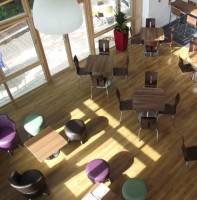September 17, 2013
New research sheds light on why executives persist in stressful work habits
There’s a fine line between enjoying the stimulation of a demanding job and feeling burnt out. Lloyds’ chief executive, Antonio Horta-Osorio made headline news in 2011 after being signed off sick with stress and exhaustion. As the recent suicides of two Swiss banking executives have shown, it’s often difficult for pressurised workaholics to admit the job has become too much. A recent US academic study provides some clues as to why senior executives persist in working to unhealthy levels; while research by serviced office provider Business Environment reveals how UK office workers are also prone to stressful work habits. One fifth (21%) take work home at least one to two times a week, and one in five employees (19.6%) have taken time off work due to stress. (more…)




















September 13, 2013
100% Design: Holding a mirror up to the way we design and manage workplaces
by Mark Eltringham • Comment, Events, Facilities management, Furniture, Products, Workplace design
Hanging Room at 100% Design
If art holds a mirror up to nature, shouldn’t the design of workplace products hold a mirror up to the way we work? By definition, the things with which we surround ourselves should tell us something about the way we see ourselves and what we do. It should be possible to infer from the design of the products suppliers offer to the market what is changing in the workplace. This isn’t always the case, of course, especially for those firms who see design not so much in terms of putting lipstick on a gorilla as telling you that what you’re looking at isn’t in fact a gorilla at all. It’s Scarlett Johansson.
(more…)